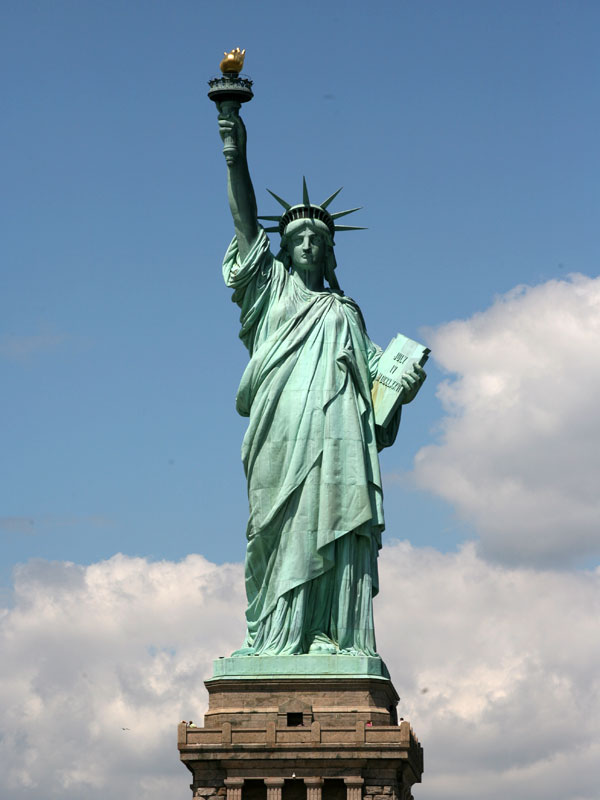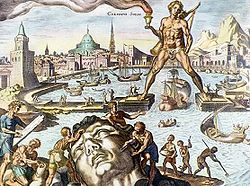Friday
Senior White House aide and white nationalist Stephen Miller wasn’t altogether wrong on Wednesday when, in announcing Donald Trump’s support of a bill severely curtailing immigration, he separated out the Statue of Liberty from the famous Emma Lazarus poem connected with it. “I don’t want to get off into a whole thing about history here,” Miller said, “but the Statue of Liberty is a symbol of liberty lighting the world, it’s a symbol of liberty lighting the world. The poem you are referring to, which was added later, is not part of the original Statue of Liberty.”
The essay below, written by a former colleague and posted on this blog in the past, notes that there was indeed a divide. The statue was designed by the French as a testimony to Enlightenment ideals whereas the poem focuses on America’s status as a nation built and sustained by immigrants.
That being said, however, Miller was more wrong than right. After all, one of the triumphs of the Enlightenment was the Declaration of Independence, which riveted the world with its assertion that “all men are created equal, that they are endowed by their Creator with certain unalienable Rights, that among these are Life, Liberty and the pursuit of Happiness.”
This belief is consonant with Lazarus’s poem and entirely at odds with the purpose of Trump’s support for anti-immigration measures. The White House was probably trying to gin up support amongst its base with the announcement, and that base has no more fondness for American-born people of color than it has for immigrants.
Ultimately, the synergy between statue and poem is greater than either one by itself. The two together inspire the world while generating attacks from the alt-Right.
By Donna Richardson, Prof. of English, St. Mary’s College of MD
The New Colossus
By Emma Lazarus, 1883
Not like the brazen giant of Greek fame,
With conquering limbs astride from land to land;
Here at our sea-washed, sunset gates shall stand
A mighty woman with a torch, whose flame
Is the imprisoned lightning, and her name
Mother of Exiles. From her beacon-hand
Glows world-wide welcome; her mild eyes command
The air-bridged harbor that twin cities frame.
“Keep, ancient lands, your storied pomp!” cries she
With silent lips. “Give me your tired, your poor,
Your huddled masses yearning to breathe free,
The wretched refuse of your teeming shore.
Send these, the homeless, tempest-tost to me,
I lift my lamp beside the golden door!”
Emma Lazarus’ sonnet “The New Colossus” is a cultural icon, so popular when originally written that it redefined the Statue of Liberty as a celebration of immigration. Yet while the sestet (or at least its last five lines) used to be a cliché memorized by every schoolchild, most Americans are completely unfamiliar with the title and the first eight lines (the octave), which more broadly redefine American culture.
The poet initially structures her poem as a comparison between the “New Colossus” and the original Colossus of Rhodes. The details of this comparison imply that America is a new kind of nation, a less patriarchal, more inclusive culture that values the worth of every human, even the most “wretched refuse,” rather than only the “storied pomp” of powerful elites in “ancient lands.” Although many of these details are evoked by the language of the poem, a visual comparison of the Statue of Liberty with recreations of the Colossus of Rhodes reinforces this cultural difference, especially the features of geography that made America less self-protective and more welcoming.
Lazarus redefines the original meaning of the Statue of Liberty, which was intended by its creator as a monument to the spirit of revolution shared by France and America. According to Wikipedia, the original name of the statue is “Enlightening the World”; she represents the Roman goddess Libertas, she carries a tablet of law on which is written “July 4, 1776,” and a broken chain lies at her feet. These details imply that the torch is intended to represent the truths of the Enlightenment, especially the legal and political writings, which inspired both the American and the French Revolutions.
But Lazarus interprets the torch as a “lamp” lighting the path of “exiles” from political oppression in the old world; echoing the word “beckon,” Liberty’s “beacon hand/ Glows” with “world-wide welcome.” The Statue is particularly welcoming of the “poor” and “homeless” who can expect no social or political future in an overpopulated Europe which has rejected them (they are the “wretched refuse” of a “teeming shore”). These refugees are “tempest-tossed” literally and figuratively; the Statue is a welcoming sight after crossing the stormy Atlantic, but more welcoming as a sign of peace after political storms which have made them “homeless.”
The poet broadens her interpretation into a general cultural contrast between old and new worlds by focusing on the visual comparison and contrast between the Statue of Liberty and another statue that stood at the entrance to a city harbor, the Colossus of Rhodes. One of the Seven Wonders of the Ancient World, the Colossus of Rhodes was built in the early third century B.C. to commemorate the repulsion of an invasion from Cyprus.
The statue represents the god Helios, wearing a crown of light beams, carrying a torch, and armed with a bow and arrow. Since the Colossus lasted only about 60 years before it was destroyed by an earthquake, there are no known accurate representations of it that survive. But later recreations of what the Colossus may have looked like suggest two major similarities with the Statue of Liberty: both wear visually-similar crowns of light, and both carry torches. More important, both statues stand at harbor mouths to announce the victorious independence of their countries and the cultural values that made such independence possible.
Liberty, however, represents very different values. To begin with, the statue is female rather than male. Lazarus emphasizes several qualities that are traditionally-gendered female ideals connected with patron goddesses or female symbols for a culture. Liberty is a “mighty woman” and her eyes “command” the harbor, but their gaze is “mild” and her power is that of a mother—the “Mother of Exiles.”
The Colossus of Rhodes, by contrast, is a “brazen giant”—“brazen” means “contemptuous boldness” in addition to “made of bronze.” He also stands “with conquering limbs,” symbolizing the military victory of Rhodes over its neighbor Cyprus. Whereas the old Colossus literally stands for physical power and intimidation, Lazarus wants to interpret Liberty as representing a less tangible, more gentle, but even more powerful new female principle of welcoming and inclusion of all in freedom and equality before the law.
Lazarus uses a spatial description of Liberty to enhance the contrast between the values of the old Colossus and the “New.” The fact that there are no known accurate portrayals of its appearance led for hundreds of years to creative and unrealistic interpretations of its appearance. Lazarus would have been familiar with the most flamboyant version, the one referred to in Shakespeare’s Julius Caesar (1.2.136-139):
Why, man, he [Caesar] doth bestride the narrow world
Like a Colossus, and we petty men
Walk under his huge legs and peep about
To find ourselves dishonourable graves.
In this version, one interpretation of which is pictured here, the Colossus bestrides the harbor with one foot on each side, armed with bow and arrow, while tiny ships sail between his legs. Such a giant statue would have been impossible to construct in that era, but the recreation emphasizes several ideas, including aggressive power and defensiveness, appropriate for guarding and controlling traffic into the entrance to a small enclosed harbor on an island.
Lazarus specifically invokes features of this visual conception of the old Colossus to emphasize that, by contrast, the New World is spatially as well as culturally welcoming and open (in fact, welcoming because open). Rather than having “conquering limbs astride from land to land,” the New Colossus “gives world-wide welcome” to those who come to her harbor. Visually, she is not “astride” either the harbor or other lands, but instead stands with her beacon on an island between the “twin cities” of Brooklyn and Manhattan (which in the late 19thcentury were still considered separate cities). The connection between these closely-related “twins” is not her physically conquering stride but her “mild eyes” that “command” the “air-bridged harbor.”
It is almost impossible to get the full scope of Lazarus’ description, including both cities that “frame” the harbor, into a photograph. The broad, open vista her words evoke, along with placing her at a “sea-washed, sunset gate” relative to Europe, visually enhances Lazarus’ vision of what makes this New Colossus new and even more powerful than the sun-god of Rhodes. She welcomes the “teeming masses” of Europe to the “open door” of a vast, apparently endless continent that dwarfs her physically in size, and whose airy openness is a metaphor for the intangibility of law, equality, and welcome which has superseded the glory of “Greek fame” with a greater moral as well as physical scope.


